Kenya. ‘Making Our Dreams Come True’.
In northern Kenya, in the Samburu region, many young girls are married off to adult men at an early age against their will.
A Centre run by nuns welcomes them to give them dignity
and a possible future.
Nothing made Lilian suspect that her childhood would abruptly end that day. Returning from school, she saw some women near her house preparing food. As she neared her home, she could see people she had never seen before. Too late, the 11-year-old realized that the guests had come for her. That same day, her parents had married her to a man. In return, his family would receive three cows, ten goats and some money. From now on, that forty-year-old stranger would be her husband.Shortly after, the man and his friends took her
to his village and kept her at his mother’s house.
After four weeks, the girl was supposed to move in with him. But Lilian didn’t want to and ran away at the first opportunity.
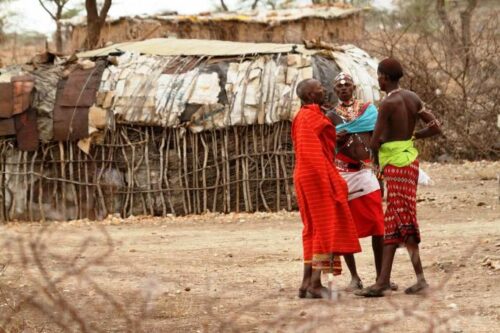
Men from the tribe of Samburu in Kenya. 123rf.com
For generations, the Samburu people, closely related to the Maasai, have lived in northern Kenya. It is a tradition among the Samburu semi-nomadic shepherds who live in the North, to marry ten-to-twelve-year-old girls to adult men.In return, the men pay a price to the girl’s family in the form of animals and money. “The girls have no say in the matter. They are treated as bargaining chips”, says Sister Teresa Nduku of the Sisters of Mary Immaculate of Nyeri (also known as Missionary Sisters of Mary Immaculate).The nun runs an Early Marriage Rescue Mission Centre in the small town of Suguta Marmar, in the Samburu region. It borders the Samburu National Park.Officially, marriage to minors is prohibited in Kenya. But many Samburu don’t care about the law. For them,
tradition is much stronger.
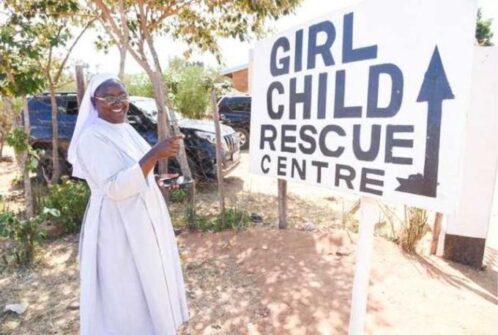
Sister Teresa Nduku at Mary Immaculate Girl Child Rescue Centre in Suguta Mar-Mar, Samburu County. (Photo: Evans Habil/Nation Media Group).
At school, Lilian had heard about the Centre. On the run from her ‘husband’ she decided to head for the Suguta Marmar Centre, a full day’s walk and a dangerous road due to the presence of wild animals. In the evening she finally reached the Centre, completely exhausted but relieved. At the moment, there are 62 girls fleeing forced marriages who have found hospitality in the Centre. The nuns take care of the girls and organize their schooling and provide them with therapeutic support. “The girls who come to us are often traumatized and heartbroken”, explains Sister Teresa, who is trained as a teacher and therapist. She also holds a BA in ‘Rights, Equality and Protection of Children’ from the Catholic University of East Africa. “When we work with them, they start to develop and become confident girls”, says the nun.
A group of girls sit under a tree on a stone bench and prepare lunch. Lilian is also helping. She has been living at the Centre now for a few months. But the dangers are always there outside the door. Meanwhile, thanks to Sr. Teresa she was able to reconcile with her family. Lilian’s brother Lthau-sen has promised her to return the bride price to her ‘husband’. Lilian’s dad has been dead for a few months and her brother wants her to finish school. He wants her to have a better life than his.
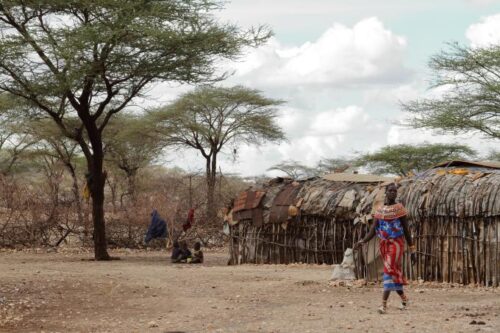
Village and houses of the Samburu tribe in Kenya. ©hecke/123RF.COM
In the meantime, however, Lilian’s ‘husband’ does not give up. Lilian is his property. He wants her back.Twice he had Lilian kidnapped. The first time he sent some young Samburu. They entered at night and dragged her off with them. The next morning, Sister Teresa, Lilian’s mother, her brother, and the police started looking for the girl. Lilian succeeded in escaping her captors after a few days. She managed to warn Sister Teresa and her brother. He joined her first and watched over her until the nun could pick her up. Later, Sr. Teresa decided to sleep at the Centre. “I decided to do this …. to ensure their safety,” explains Sister Teresa. “I also alerted police officers and asked them to stand guard near the Centre”. But all the precautions did not help.
A few months later, some young men ambushed Lilian on her way home from school and dragged her away with them. Again, Sister Teresa informed the police. After a few days, an officer contacted her and told her that Lilian was safe and in police custody, 200 kilometres from the protection Centre. She had managed to escape again.
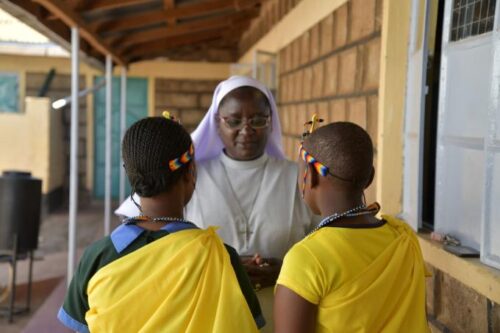
Sister Teresa Nduku, speaks to girls who were rescued from early marriages. (Photo: Evans Habil/Nation Media Group)
A stranger had found her weak and hungry by the side of the road and had taken her to the police station. “He was a good Samaritan”, says Sister Teresa. She immediately set off to fetch the girl.Lilian isn’t the only one in danger. Two other girls were also taken from the shelter. For this reason, Sister Teresa wants to build an electric fence around the buildings and the garden to keep away wild animals and kidnappers. “Girls really want to live in peace and in security”, says the nun.Lilian is very upset by the events. But her desire to go to school remains unaffected even after her ‘husband’s’ kidnapping attempts. “I want to go to a boarding school in another part of Kenya,” she says, “away from here where ‘he’ can’t find me.” Sister Teresa would be delighted to grant this wish.Sarah was luckier than Lilian. The 15-year-old no longer has to worry about her safety. She had been married off at the age of eleven. The chosen ‘husband’ was a man of fifty! During the wedding preparations, it was Sarah’s brother Franklin who intervened. He took his sister to the police. The family was sentenced to a heavy fine. But Sarah’s brother does not regret his intervention.
“In the eyes of the elders, I broke a taboo. Afterwards, I had to hide for some time”, Franklin says. “But I went to school. I know that education can change your life. I want my sister to have that chance too. I want her to get a good job. One day she will shame those who are against us today”. Today Sarah lives in the reception Centre. Thanks to the mediation of Sister Teresa, she was reconciled with her parents. Her family was able to repay the bride price and now allows her to go to school.At school, many of the girls at the Centre are among the best. “These girls are very smart”, Sister Teresa says, and you can tell how proud she is. Since its foundation in 2002, 450 girls have found refuge in the facility. Some have undergone professional training. They work as policewomen or teachers or have started their own businesses.
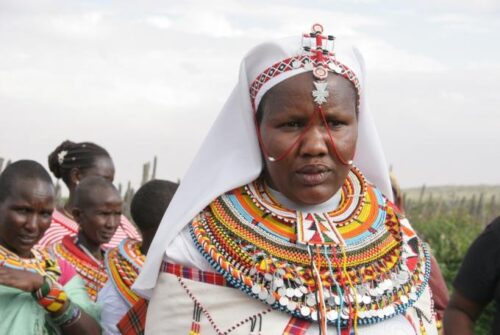
Sister Roseline Lenguris is the first and only Samburu of h Sisters of Mary Immaculate of Nyeri. order. (Photo: Evans Habil/Nation Media Group)
Sister Roseline Lenguris is the first and only Samburu of her order. As a girl, she refused to marry and joined the order. The village elders, therefore, expelled her from the community. But Sister Roseline did not let herself be dissuaded from her path. After years of being ostracized by her village, today the community respects her.
The girls at the protection Centre admire Sister Roseline. When she comes to the Centre, they want to meet her. They are especially proud of a poem written by one of them: ‘We! Yes! Survivors of child marriage and genital mutilation. We want to change our community. Let girls get an education. We are girls with a vision! Help us make our dreams come true’. And they all have dreams. Sarah wants to be a surgeon when she grows up. Lilian wants to become ‘a nun like Sister Teresa’ and teach at a school. After a short pause, she adds “I, too, want to help many girls to be themselves and to choose their future by fulfilling their dreams”. (Open Photo: Young African girls from the Samburu tribe. 123rf.com)
Bettina Tiburzy/Kontinente



